Mikhaïl Kalatozov is a Actor, Director, Scriptwriter, Producer, Camera Production Assistant and Additional Writing Russe born on 28 december 1903 at Tbilisi (Georgie)
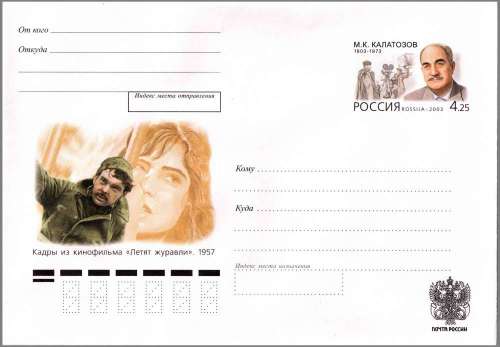
Mikhail Konstantinovich Kalatozov (Georgian: მიხეილ კალატოზიშვილი, Russian: Михаи́л Константи́нович Калато́зов) (28 December 1903 – 27 March 1973), born Mikheil Kalatozishvili, was a Georgian/Russian film director. Born in Tiflis (now Tbilisi), he studied economics before starting his film career as an actor and later cinematographer.
He directed several documentary films, including Salt for Svanetia (1930), but was forced to withdraw from his profession after his film Nail in the Boot (1931) was banned by Stalinist censors. During World War II he directed several propaganda films and worked as a cultural attaché at the Soviet embassy in the United States.
During the 1950s he directed several other films. His four final features, The Cranes Are Flying (1957), The Unsent Letter (1959), I Am Cuba (1964), and The Red Tent (1971), are among his most famous works.
He died in Moscow.
Il est le père de Georgui Kalatozichvili et le grand-père du réalisateur Mikhaïl Kalatozichvili.
Source : Wikidata
Mikhaïl Kalatozov

- Infos
- Photos
- Best films
- Family
- Characters
- Awards
Birth name Mikheïl Kalatozichvili მიხეილ კალატოზიშვილი
Nationality Russie
Birth 28 december 1903 at Tbilisi (Georgie)
Death 27 march 1973 (at 69 years) at Moscow (Russie)
Awards People's Artist of the USSR, State Stalin Prize
Nationality Russie
Birth 28 december 1903 at Tbilisi (Georgie)
Death 27 march 1973 (at 69 years) at Moscow (Russie)
Awards People's Artist of the USSR, State Stalin Prize
He directed several documentary films, including Salt for Svanetia (1930), but was forced to withdraw from his profession after his film Nail in the Boot (1931) was banned by Stalinist censors. During World War II he directed several propaganda films and worked as a cultural attaché at the Soviet embassy in the United States.
During the 1950s he directed several other films. His four final features, The Cranes Are Flying (1957), The Unsent Letter (1959), I Am Cuba (1964), and The Red Tent (1971), are among his most famous works.
He died in Moscow.
Biography
Après avoir suivi des études d'économie, il reçoit en 1937 le diplôme de l'Académie des Arts de Leningrad. Il débute au cinéma comme acteur puis poursuit comme opérateur pour des films comme Guioulli en 1927 ou Le Sel de Svanétie en 1930. En 1932, son film La griffe dans la botte ou Le clou dans la botte est interdit. De 1941 à 1945, il est attaché culturel à Los Angeles et de 1946 à 1948, il est vice-ministre du cinéma de l'URSS. Le prix Staline de 2e classe lui est décerné en 1950, pour le film Le Complot des condamnés tiré de la pièce éponyme de Nikolaï Virta qui signe le scénario. Le film recevra également un prix spécial de la Paix au Festival international du film de Karlovy Vary la même année. Kalatozov remporte la Palme d'Or du Festival de Cannes en 1958, avec Quand passent les cigognes. Son film Soy Cuba traitant de la révolution cubaine est oublié puis est redécouvert dans les années 1990. En 1967, il est réalisateur aux studios Mosfilm.Il est le père de Georgui Kalatozichvili et le grand-père du réalisateur Mikhaïl Kalatozichvili.
Best films
Usually with
Filmography of Mikhaïl Kalatozov (8 films)
Actor

Wings of Victory (1941)
, 1h37Directed by Mikhaïl Kalatozov
Genres Drama, War, Biography
Themes Transport films, Aviation films
Actors Mikheil Gelovani, Mark Bernes, Mikhaïl Kalatozov, Boris Andreyev, Arkadi Raïkine
Rating64%





Valeri Tchkalov, l'un des meilleurs pilotes de voltige aérienne, s'ennuie dans les chartes et les instructions, il cherche à faire des virages vertigineux, des vols ultra-bas, etc. Un jour, il effectue le vol sous le pont de la Neva à Leningrad et se voit expulsé de son unité.
Director

The Red Tent (1969)
, 2h1Directed by Mikhaïl Kalatozov
Origin Russie
Genres Drama, Action, Adventure, Historical
Themes Transport films, Aviation films
Actors Sean Connery, Claudia Cardinale, Peter Finch, Nikita Mikhalkov, Yuri Vizbor, Donatas Banionis
Rating68%





The film begins in Rome many years after the expedition. Nobile has endured years of scorn for his actions during the disaster and its aftermath. He imagines his apartment turned into a court of inquiry against him, where witnesses and judges are his former crewmen – including Captain Zappi, his navigator and his meteorologist Finn Malmgren. Also arrayed against him are Valeria, Malmgren's lover, Captain Romagna, one of the expedition's would-be recuers, famed aviator Lundborg, professor Samoilovich, chief of the Soviet rescue mission, his pilot Boris Chukhnovski, and Roald Amundsen who lost his life in the search for survivors of Nobile's expedition.

I Am Cuba (1964)
, 2h23Directed by Mikhaïl Kalatozov
Origin Russie
Genres Drama
Themes Seafaring films, Politique, Transport films, Political films
Actors Sergio Corrieri, Jean Bouise, Celia Rodriguez
Rating81%





Tourné à partir de janvier 1963, Soy Cuba fut mal reçu à sa sortie en 1964 aussi bien en URSS qu'à Cuba. Il donna notamment lieu à une polémique à Cuba pour son ambiguïté dans la présentation de la société cubaine à la fin de l'ère Batista. Il fut par ailleurs interdit dans les cinémas américains durant la guerre froide. Il tomba donc dans l'oubli jusqu'à sa redécouverte grâce au romancier Guillermo Cabrera Infante, qui le fit projeter au Festival du film de Telluride en 1992. Projeté ensuite au Festival international du film de San Francisco en 1993, il soulève l'enthousiasme de Martin Scorsese et de Francis Ford Coppola, qui en parrainent la diffusion.
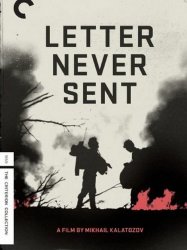
Letter Never Sent (1960)
, 1h37Directed by Mikhaïl Kalatozov
Genres Drama, Adventure, Romance
Actors Tatiana Samoïlova, Innokenti Smoktounovski, Vassili Livanov
Rating77%





A guide and three geologists head to the boreal forest of central Siberia. After much strenuous effort and nearly running out of food, they succeed in finding diamonds in Bolshaya Zemlya. Before they can return, they are trapped by a forest fire that cuts them off from the canoe where their supplies are kept. Now the battle is to survive.

The Cranes Are Flying (1957)
, 1h38Directed by Mikhaïl Kalatozov
Origin Russie
Genres Drama, War, Romance
Themes Politique, Political films
Actors Tatiana Samoïlova, Alexeï Batalov, Vasili Merkuryev, Valentin Zubkov, Valentina Ananina, Maïa Boulgakova
Rating82%





Fyodor Ivanovich is a doctor who lives with his son, Boris; his daughter, Irina; his mother; and his nephew, Mark. The film centers on Boris's girlfriend, Veronika, during World War II.The character of Veronica represents Soviet women in the context of the aftermath of the aforementioned war.
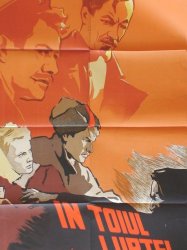
Hostile Whirlwinds (1956)
, 1h43Directed by Mikhaïl Kalatozov
Genres Drama, Historical
Themes Political films
Actors Vladimir Yemelyanov, Mikheil Gelovani, Viktor Avdyushko, Georgi Yumatov, Nikolai Gritsenko, Andrei Popov
Rating63%





Film exercises the first years of Soviet government, biography of Felix Dzerzhinsky in 1918-1921.
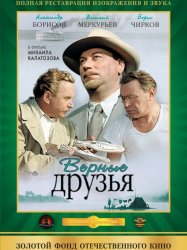
True Friends (1954)
, 1h42Directed by Mikhaïl Kalatozov
Genres Comedy, Adventure, Romance
Actors Vasili Merkuryev, Boris Chirkov, Aleksandr Borisov
Rating73%





Alexander, Boris and Vasily are three old friends, who now rarely see each other as they are busy with their professional life. They embark on long-planned voyage on a raft down the Volga river, which turns into a series of comical accidents but also strengthens their friendship.

Wings of Victory (1941)
, 1h37Directed by Mikhaïl Kalatozov
Genres Drama, War, Biography
Themes Transport films, Aviation films
Actors Mikheil Gelovani, Mark Bernes, Mikhaïl Kalatozov, Boris Andreyev, Arkadi Raïkine
Rating64%





Valeri Tchkalov, l'un des meilleurs pilotes de voltige aérienne, s'ennuie dans les chartes et les instructions, il cherche à faire des virages vertigineux, des vols ultra-bas, etc. Un jour, il effectue le vol sous le pont de la Neva à Leningrad et se voit expulsé de son unité.
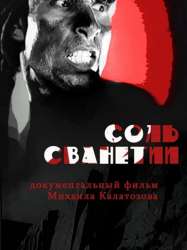
Salt for Svanetia (1930)
, 55minutesDirected by Mikhaïl Kalatozov
Origin Georgie
Genres Drama, Documentary, Historical
Rating75%





Most of Salt for Svanetia describes and explores the daily life of the Svan people, who are living isolated from civilisation in a harsh natural environment in the mountainous region of Svanetia. The film starts with the Lenin quotation "Even now there are far reaches of the Soviet Union where the patriarchal way of life persists along with remnants of the clan system." Svanetia and the mountain village of Ushguli are then located on two slowly dissolving maps of the region and are described as "cut off from civilization by mountains and glaciers". The location of the village is further introduced by several expository shots showing the Svanetian landscape. These shots give some emphasis to tall towers (still visible in the 2006 photograph below). It explains that these have been constructed by villagers to serve as a defense against feudal overseers, and it shows how villagers have used them to fend off tax collectors by heaving rocks from the tower tops. This introductory focus on class conflict fades as the film moves to concentrate on the daily routine of the villagers. One sequence shows how sheep are raised, another how wool and yarn are produced, and another on how barley is threshed. These sequences powerfully convey the technological underdevelopment of the area. Wool spinning technique antedates the spinning wheel; barley is threshed by cattle dragging a stone studded platform, weighed down by a mother tending to her child, over the barley. Another scene shows a suspension bridge and a man trying to cross over rushing water as his pack animals resist. A desperate harvest during an early July snowstorm is shown. Other scenes show how the Svan people tailor their clothes, make hats, cut their hair and bury their dead.
Scriptwriter

Salt for Svanetia (1930)
, 55minutesDirected by Mikhaïl Kalatozov
Origin Georgie
Genres Drama, Documentary, Historical
Rating75%





Most of Salt for Svanetia describes and explores the daily life of the Svan people, who are living isolated from civilisation in a harsh natural environment in the mountainous region of Svanetia. The film starts with the Lenin quotation "Even now there are far reaches of the Soviet Union where the patriarchal way of life persists along with remnants of the clan system." Svanetia and the mountain village of Ushguli are then located on two slowly dissolving maps of the region and are described as "cut off from civilization by mountains and glaciers". The location of the village is further introduced by several expository shots showing the Svanetian landscape. These shots give some emphasis to tall towers (still visible in the 2006 photograph below). It explains that these have been constructed by villagers to serve as a defense against feudal overseers, and it shows how villagers have used them to fend off tax collectors by heaving rocks from the tower tops. This introductory focus on class conflict fades as the film moves to concentrate on the daily routine of the villagers. One sequence shows how sheep are raised, another how wool and yarn are produced, and another on how barley is threshed. These sequences powerfully convey the technological underdevelopment of the area. Wool spinning technique antedates the spinning wheel; barley is threshed by cattle dragging a stone studded platform, weighed down by a mother tending to her child, over the barley. Another scene shows a suspension bridge and a man trying to cross over rushing water as his pack animals resist. A desperate harvest during an early July snowstorm is shown. Other scenes show how the Svan people tailor their clothes, make hats, cut their hair and bury their dead.
Producer

The Cranes Are Flying (1957)
, 1h38Directed by Mikhaïl Kalatozov
Origin Russie
Genres Drama, War, Romance
Themes Politique, Political films
Actors Tatiana Samoïlova, Alexeï Batalov, Vasili Merkuryev, Valentin Zubkov, Valentina Ananina, Maïa Boulgakova
Roles Producer
Rating82%





Fyodor Ivanovich is a doctor who lives with his son, Boris; his daughter, Irina; his mother; and his nephew, Mark. The film centers on Boris's girlfriend, Veronika, during World War II.The character of Veronica represents Soviet women in the context of the aftermath of the aforementioned war.
Cameraman

Salt for Svanetia (1930)
, 55minutesDirected by Mikhaïl Kalatozov
Origin Georgie
Genres Drama, Documentary, Historical
Roles Camera Operator
Rating75%





Most of Salt for Svanetia describes and explores the daily life of the Svan people, who are living isolated from civilisation in a harsh natural environment in the mountainous region of Svanetia. The film starts with the Lenin quotation "Even now there are far reaches of the Soviet Union where the patriarchal way of life persists along with remnants of the clan system." Svanetia and the mountain village of Ushguli are then located on two slowly dissolving maps of the region and are described as "cut off from civilization by mountains and glaciers". The location of the village is further introduced by several expository shots showing the Svanetian landscape. These shots give some emphasis to tall towers (still visible in the 2006 photograph below). It explains that these have been constructed by villagers to serve as a defense against feudal overseers, and it shows how villagers have used them to fend off tax collectors by heaving rocks from the tower tops. This introductory focus on class conflict fades as the film moves to concentrate on the daily routine of the villagers. One sequence shows how sheep are raised, another how wool and yarn are produced, and another on how barley is threshed. These sequences powerfully convey the technological underdevelopment of the area. Wool spinning technique antedates the spinning wheel; barley is threshed by cattle dragging a stone studded platform, weighed down by a mother tending to her child, over the barley. Another scene shows a suspension bridge and a man trying to cross over rushing water as his pack animals resist. A desperate harvest during an early July snowstorm is shown. Other scenes show how the Svan people tailor their clothes, make hats, cut their hair and bury their dead.
Team

The Red Tent (1969)
, 2h1Directed by Mikhaïl Kalatozov
Origin Russie
Genres Drama, Action, Adventure, Historical
Themes Transport films, Aviation films
Actors Sean Connery, Claudia Cardinale, Peter Finch, Nikita Mikhalkov, Yuri Vizbor, Donatas Banionis
Roles Additional Writing
Rating68%





The film begins in Rome many years after the expedition. Nobile has endured years of scorn for his actions during the disaster and its aftermath. He imagines his apartment turned into a court of inquiry against him, where witnesses and judges are his former crewmen – including Captain Zappi, his navigator and his meteorologist Finn Malmgren. Also arrayed against him are Valeria, Malmgren's lover, Captain Romagna, one of the expedition's would-be recuers, famed aviator Lundborg, professor Samoilovich, chief of the Soviet rescue mission, his pilot Boris Chukhnovski, and Roald Amundsen who lost his life in the search for survivors of Nobile's expedition.
 Connection
Connection



